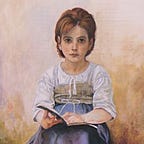Distance to 5 and 10 (Game 1)
Learning to count is actually a long journey that many of us, adults, have completely forgotten. Operations such as 8 + 5 or 7 — 4 seem so easy that we don’t realise that… they’re not! Here, I want to propose a series of games to play with children at home or at school that will support them along their learning journey by developing their number sense.
Rather than counting in ones, an effective strategy is to rely on number partition, that is, the ability to split a number in two other numbers. The game I propose here reinforces the knowledge of the possible partitions of 5 and 10 by finding the distance of a number to 5 or 10. It will also show how to partition a number from 6 to 10 as 5 plus another number.
It’s not a coincidence that we have both 10 fingers and a decimal number system. Children often count on their fingers first. It has been proposed that “fingers (which are used to count all kinds of different things) stand in between the concrete things that are counted and the abstract concept of number itself, and therefore help children develop an initial level of numerical representation that is more abstract than touchable items and through which addition and subtraction may be understood and generalized.”[1]
When I work with year 2 children, I ask them to put their hands on the table in front of them, palm down, and count their fingers from 1 to 10, starting from the little finger on the left hand, and drop and touch the table with each finger when it is counted. The correlation between the ability to do that activity and their ability to count is obvious. The association between children’s ability to individuate fingers (finger gnosis) and mathematics ability has actually been reported in the literature (see above citation). The above exercise is however useful to show children how to use their fingers as a scaffold for a spatial representation of the numbers — e.g. the number 3 is represented with 3 fingers — and the positions of the numbers on a number line. This scaffold can prove very useful for the transition between the stage of counting on fingers and the mental representation of numbers organnised on a number line.
The distance to 5 of a number smaller than or equal to 10 can be visualised using our hands as shown below.
Some children may recognise the number 8 if you show a full hand and 3 fingers like on the image above, but not necessarily associate this with a partition of the number 8, e.g. that 8 = 5 + 3, and so 8 –3 = 5 and 8–5 = 3. It is then important to explain to them that when we find the distance between e.g. 2 and 5, we find the number that added to 2 gives 5, so 2 + 3 = 5, and don’t forget to give the corresponding subtractions 5–3 = 2 and 5–2 = 3.
The distance to 10 of a number smaller than 10 can be found similarly by bending down this number of fingers: the distance to 10 is then the number of fingers still up (of course, we can swap the fingers down and up). In this way, we can find all the number bonds to 10: 10 + 0, 9 + 1, 8 + 2 , 7 + 3, etc. and all corresponding subtractions.
For the game, you need a “bank” made of a set of 1, 2, 5, 10, 20, and 50 p coins and a few pound coins, as well as a10-sided die. The game consists in taking turns and rolling the 10-sided die. Then, depending on the game you are playing, the player
- Collects in pence the result of the distance of the number displayed on the die to 5,
- Collects in pence the result of the distance of the number displayed on the die to 10,
- Collects the distance to 5 if the number is > 5; Lose the distance to 5 if the number is < 5. [For this variation, each player starts with 20 p.]
The variations of the game can be combined in one single game when players are more familiar with the procedures, by using for instance a 6-sided die and sticking a label on its faces with A, B, or C, with A the first variation, B the second and C the third.
There’s no need to have a very large number of coins since exchanging several low-value coins (when there are not enough of them left in the bank) against a coin of higher value is part of the game (both in terms of enjoyment and learning). The kids love collecting money and won’t notice they’re doing maths. They will also often count how much they have. You can show them how to count efficiently, e.g. by making piles that add up to 10 p for the small coins before actually counting. And as they will inevitably do a race, you can try to avoid possible disappointments by explaining they are all “running” for a fundraising event, and so what counts is the total sum!
[1] Firat Soylu, Frank K. Lester Jr., Sharlene D. Newman, You Can Count on Your Fingers: The Role of Fingers in Early Mathematical Development, Journal of Numerical Cognition, 2018, Vol. 4(1), 107–135, doi:10.5964/jnc.v4i1.85
